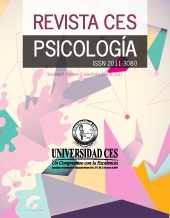Anxiety, Memory and Post-Traumatic Stress Disorder
DOI:
https://doi.org/10.21615/cesp.11.2.5Keywords:
Post-Traumatic Stress Disorder, PTSD, anxiety, MemoryAbstract
A Post Traumatic Stress Disorder (PTSD) may appear after experiencing a stressful situation and is characterized by recalling the trauma, avoiding situations that remind it, and through persistent hyperarousal. Its etiology and symptoms suggest the involvement of various behavioral systems, such as an exaggerated aversive conditioning, difficulty in extinguishing the traumatic memory and behavioral sensitization, which is characterized by an intense response before moderate stressors not related to trauma. Regarding to the neurobiology of the disorder, it is suggested a reduction in the volume of the hippocampus and prefrontal cortex, an exaggerated responsiveness of amygdala with alteration of its modulation by ventromedial prefrontal cortex and hippocampus, sympathetic hyperfunction of the adrenal axis and hypothalamic hypofunction of pituitary-adrenal axis. It is concluded that PTSD is a disorder related to anxiety and memory.
Downloads
References
Andrade R.E., Castelán O.A., Martínez C.A., Estrada J. (2013). Reducción de las emisiones de metano en la fermentación ruminal in vitro, utilizando planta taníferas. Recuperado de: http://www.engormix.com/MA-ganaderia-carne/manejo/articulos/amena-reduccion-emisiones-metano-t4755/124-p0.htm
Angeles S. 2003. Fermentación Ruminal, tamaño de partícula y efecto de la fibra en la alimentación de vacas lecheras. Departamento de nutrición Animal y Bioquímica. [versión pdf]. Recuperado de: http://www.fmvz.unam.mx/fmvz/departamentos/rumiantes/bovinotecnia/BtRgZooG014.pdf.
Berra G. y Finster L. (2002). Emisión de gases de efecto invernadero; influencia de la ganadería argentina. Cadena de la carne vacuna, Tecnologías Para Nuevos Escenarios. Instituto De Patobiología, INTA Cautelar. Proyecto metas de emisión. Idia 21(2):212-215.
Bonilla J. A., Lemus F. Clemente, (2012). Emisión de metano entérico por rumiantes y su contribución al calentamiento global y al cambio climático. Revisión. Rev Mex Cienc Pecu. 18 (1) :49 – 63.
Brandan, N. y Aispuru G. (2005). Metabolismo de compuestos nitrogenados. Universidad Nacional del Nordeste. Cátedra de Bioquímica. [versión pdf]. Recuperado de: http://med.unne.edu.ar/catedras/bioquimica/pdf/nitro.pdf
Cairó y París, (1988). Etapa metanogénica. Recuperado de: Http://Web.Udl.Es/Usuaris/R5213847/Metanog.Html.
Carmona J., Bolívar D., Giraldo L.A. (2005). El gas metano en la producción ganadera y alternativas para medir sus emisiones y aminorar su impacto a nivel ambiental y productivo. Rev Col Cienc Pec Vol. 18 (1):49 – 63.
Decreto N° 086, 2008. Por medio del cual se anula el decreto n° 154 de ju nio 6 de 2008, se asigna un nuevo decreto y se adopta el plan de desarrollo “gestion social y trabajo comunitario. Junio 23. [versión pdf] [online].
Fondevila M. y Barrios A. (2001). La técnica de producción de gas y su aplicación al estudio del valor nutritivo de los forrajes Revista Cubana de Ciencia Agrícola. Dpto. de Producción Animal y Ciencia de los Alimentos, Universidad de Zaragoza. Maracaibo. Venezuela. Tomo 35, No. 3: 197-206.
Giraldo, L. A., L. A. Gutiérrez, C. Rúa. (2007). Comparación de dos técnicas in vitro e in situ para estimar la digestibilidad verdadera en varios forrajes tropicales.Rev Col Cienc Pec. 20(3): 269-279.
Goering, H. K., P. J. Van Soest (1970). Forage fiber analyses. Manual de agricultura. 379. U.S. Government Printing Office, Washington Dc, USA.
Hunter, R.A. (2007). Methane production by cattle in the tropics. British Journal of Nutrition. Vol 98. Núm 03: 657
Kamande G. M. (2006). DIGESTIÓN RUMINAL Y NUTRICIÓN. Congreso De Forrajes. Producir XXI, Bs. As., 15(180):52-57.
Keuren, R.N. y Heinemann, W. (1962). Study of a nylon bag technique for in vivo estimation of forage digestibility. J. Anim. Sci., 21:340.
Kurihara M., Magner T., Mccrabb H., y Mccrabb G. (1999). Methaneproduction and energy partition of cattle in the tropics. British Journal Of Nutrition, 81: 227-234.
Lascano E. y Argel J., (2011). Descripción y atributos de especies y cultivares de Bothriochloa. Seminario Taller sobre B. pertusa. Comité de Ganaderos de Ibagué. Referenciado por: Piñeros R., Tobar V., y Mora J. 2011. Evaluación agronómica y zootécnica del pasto colosuana (bothriochloa pertusa) en el trópico seco del tolima. UT. Ibagué -Tolima
Masson L. (2007). Métodos analíticos para la determinación de humedad, alcohol, energía, materia grasa y colesterol en alimentos. Depósito de documentos de la FAO. Capitulo 14. Recuperado de: http://www.fao.org/docrep/010/ah833s/ah833s16.htm.
Montoya J., Torregroza L., Palomino M., González M., Cuadrado H., Reza S., y Gómez U., (2003). Análisis técnico y económico de un modelo de producción de carne en el valle del sinú. Universidad De Córdoba, Departamento De Zootecnia. Corpoica, Colombia. Córdoba. 8:(1): 265-272.
Owens, F. N., Secrist D. S., Hill W. J., Y Gill D. R. (1998). Acidosis in catttle: A Rev. J. Anim. Sci. 76:275-286
Palladino A. Wawrzkiewicz M. y Bargo F. (2006). La fibra. Departamento De Producción Animal, Facultad De Agronomía, Uba. Bs. As., 202:82-84.
Pérez R. M. (2011). Evaluación de la composición nutricional y digestibilidad aparente e ileal en porcinos del frijol mungo (vigna radiata o phaseolus aureus) con y sin tratamiento térmico. Tesis pregrado. Universidad del Tolima. Ibagué – Tolima
Relling, A. E. y Mattioli, G. A., (2008). Fisiologia digestiva y metabolica de los rumiantes. Corresponde a una actualización de los autores del libro "fisiología digestiva y metabólica de los rumiantes" De Editorial EDULP (Ediciones 2002 Y 2003) Fac. Cs. Veterinarias – UNLP.
Rios J., Gallego A., Vélez L., Otalvaro J., Toro L., Lema A. y Acevedo L. (2004). Caracterización y evaluación de agrosistemas a escala predial. Un estudio de caso: centro agropecuario Paysandú (Medellín – Colombia). Rev Fac. Nal. Agr. Medellín. Vol. 57. Nº2.
Theodorou, M. K., B. A. Williams, M. Dhanoa, A. Mcallan, J. France. (1994). A simple gas production method using a pressure transducer to determine the fermentation kinetics of ruminant feeds. Animal Feed Science And Technology 48: 185-197.
Tiemann T., Lascano E., Wettstein R., Mayer C., Kreuzer M. y Hess D. (2008). Effect of the tropical tannin-rich shrub legumes calliandra calothyrsus and flemingia macrophylla on methane emission and nitrogen and energy balance in growing labs. The Animal Consortium. 2(5): 790–799
Tilley, J.A. y Terry, R.A. (1963). A two stage technique for the in vitro digestion of forage crops. J. Br. Grassl. Soc., 18:104.
Van Soest, J., Robertson J. y Lewis, B.A., (1991). Methods for dietry fiber, neutral detergent fiber and non-starch polysaccharides in relation to animal nutrition. J. Diary Sci. 74-3583-3597.
Van Soest, P.J. (1994). Nutritional ecology of the ruminant. 2ª Edition. Cornell University Press. USA. Pp. 253-316.
Van Kessell J. y Russell J. (1996). The effect of ph on ruminal methanogenesis. Fems Microbiology Ecology, 20:205-210
Vargas, E. Cárdenas, M. Pabón y J. Carulla, (2012). Emisión de metano entérico en rumiantes en pastoreo. Grup.Invest. Nutrición Animal. Dpto Producción Animal. Facultad De MVZ. [Versión pdf]. Universidad Nacional De Colombia. Bogotá.
Zavaleta L., s.f. Los ácidos grasos volátiles, fuente de energía en los rumiantes. Departamento de nutrición y bioquímica. UNAM. Ciencia veterinaria. [Versión pdf]. 223-240
Downloads
Published
How to Cite
Issue
Section
License
Copyright (c) 2018 Marília Bazan Blanco, Azair Liane Matos Canto de Souza

This work is licensed under a Creative Commons Attribution-NonCommercial-ShareAlike 4.0 International License.
Each manuscript is accompanied by a statement specifyingThat the materials are unpublished, that have not been previously published in printed formatElectronic and that they will not be presented to any other means before knowing the decision of the magazine. ThroughoutIn case, any previous publication, sea in printed or electronic form, must be made known to the editorial staffWriting The authors attach a signed statement stating that, and the manuscript is acceptedFor publication, the rights of reproduction are the exclusive property of the Journal CES Psychology.


